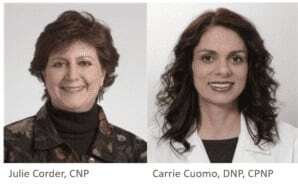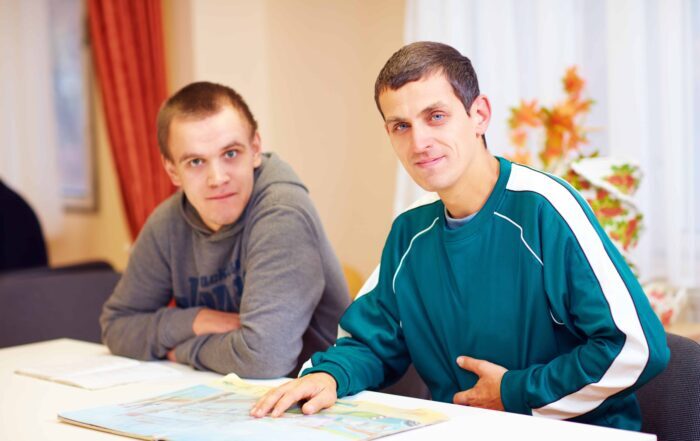Julie Corder, CNP, and Carrie Cuomo, DNP, CPNP, with the Cleveland Clinic Learning Hospital, discuss the critical stages of transition from pediatric to adult healthcare for individuals with complex medical needs. They define health care transitions (HCT), outline core elements for a successful HCT, and provide various resources. The presenters consider potential timelines and goals for different stages of HCT and discuss what turning 18 means in the US. Cuomo and Corder underscore the role that telehealth can play in HCT and share a video resource with explanations and social stories. Throughout the presentation, the speakers emphasize that it is never too late or too early to begin preparing for HCT and that transition plans are individual and different. They close with a question and answer session where they discuss insurance, COVID anxiety, social workers, and more.
Handouts are online HERE
Take the knowledge quiz for this webinar HERE
In this webinar:
00:56 – Learning objectives
2:19 – Statistics
4:30 – Transitions as a process
8:03 – Transition vs transfer
10:13 – Got Transition resource
11:50 – Switching physicians
13:10 – Six core elements of transition
15:44 – Transition readiness questionnaire and example
17:20 – HCT Timeline and goals, 12 – 14
20:40 – HCT Timeline and goals, 14 – 16
24:27 – HCT Timeline and goals, 16 – 17
27:20 – Turning 18
29:08 – HCT Goals, 18+
30:25 – Identifying caregivers
30:38 – Example: Transition of care plan
31:27 – Example: Documents transfer
32:33 – Transition resources
36:32 – Finding an adult provider
38:23 – CARES Telehealth meet and greets
39:10 – Video: Tele-transitions and social stories
42:07 – Questions for your new care providers
44:55 – Create your goal
46:12 – Quote
47:06 – Q & A
Carrie Cuomo outlines the presentation objectives (00:56) and notes that individuals with autism do not receive health care transition services (HCTS) at the same rate as their non-autistic peers (2:09). She provides statistics on co-occurring conditions and the number of autistic youth that turn 18 every year (3:08). Cuomo defines a health care transition (HCT) as
“… the process of moving from a child/family-centered model of health care to an adult/parent-centered model of health care, with or without transferring to a new clinician. It involves planning, transfer, and integration into adult-centered health care model (4:30).”
The speaker underscores that transitions are personal and take many years (6:17) and that it is essential to celebrate the small victories (9:20). Cuomo suggests Got Transition as a resource with various tools that can be individualized and reproduced for youth, parents, providers, and educators (10:13). She highlights that there is no wrong way to make an HCT and notes that adult providers often include management of conditions that specialists manage for children (11:00). The presenter lists the six core elements of transition as practiced in their profession:
- Receive a transition policy
- Transition tracking and monitoring
- Transition readiness assessment to detect knowledge gaps and strengths
- Transition planning
- Transfer of care (where you actually change providers)
- Transfer completion and feedback
Julie Corder (17:05) provides suggestions for HCT timelines and goals for individuals of different ages. She notes that the ages are simply a range and that it is never too early or too late to begin planning for HCT. The timelines and goals are summarized below.
Timeline (17:20) and HCT Goals (19:07): 12 – 14 years
It is crucial to ask providers how long they will take care of someone and if they are prepared to assist in HCT for your teen. Caregivers can help youth learn about their own health conditions, medications, and allergies and endorse time alone with the teen and provider for part of each visit. Assistive technology (AT) devices are often used to support independence for individuals with communication difficulties and can encourage teens to ask their doctor questions about their own health. Youths should aim to communicate directly with their providers for a portion of the visit and prepare for appointments by writing down questions beforehand.
Timeline (20:40) and HCT Goals (22:40): 14 – 16 years
Parents/guardians and teens can complete a readiness assessment and discuss it with their practitioner. Caregivers can also help youth learn more about their health, emergency management, how to order and refill prescriptions, and how to make appointments. Corder suggests encouraging teens to see their provider alone for part of each visit. Teens can aim for an ability to summarize their health history in three sentences or less to share with providers and to know medications, dosage, allergies, and routines independently. At this point, Corder suggests that teens and caregivers actively discuss HCT with each other and their providers.
Timeline (24:27) and HCT Goals (26:34): 16 – 17 years
Youth should carry contact information for medical providers and insurance in their wallet or phone. They can learn to use patient portals and should explore shared decision-making via agencies and lawyers to determine the correct level of oversight after 18. It is best to begin searching for adult care providers and subspecialty providers at this point as well. Teens can aim to talk to the doctor independently and may want to see their provider on their own during an appointment. At this point, teens should know when and how to get emergency care and find their doctor’s phone number and contact.
HCT Goals (29:08): 18 years
Corder suggests that once legally an adult, individuals should know how to obtain medical information from a health portal, make and cancel appointments, get to the doctor’s office, receive a referral, and generally manage their own health care and well-being. If individuals cannot do these things on their own, Corder continues, they will need to identify someone else who can assist them and has the authority to do so (30:25).
The speaker outlines what turning 18 means in the US concerning adulthood, healthcare decisions, and confidentiality. She underscores that after 18, “… your health and medical information are private (confidential) and cannot be shared unless you give the OK.” Corder provides multiple transition plan resources, examples (32:22), and tips for finding an adult provider (36:32). She discusses the positive impacts that telehealth can have on family care and HCTS and highlights the increasing use of tele-transition services (38:23). The presenters share a video clip that explains tele-transition meet and greets and supplies virtual appointment practice videos and social stories (40:10). Corder reminds viewers that healthcare transitions are challenging, emotional, and different for every person (45:01) before opening the question and answer session (47:06).
The transition from pediatric to adult healthcare is a critical stage for all individuals, and particularly so for patients with complex medical needs. Learn about the factors to consider when navigating this challenging life period.
Handouts are online HERE
The speakers:

Take the knowledge quiz
Can’t see the quiz below? Take it online HERE
From Special to H.A.P.P.Y.
Peter Vermeulen, Ph.D., considers a positive approach to psychoeducation for autistic individuals. He draws on over 25 years of experience to illustrate contemporary changes in autism intervention focus and discourse. The speaker
Examining the Transition to Adulthood in Autism: Challenges and Opportunities in the Aim of Thriving
David B. Nicholas, Ph.D., examines the transition to adulthood and its implications for autistic individuals. He presents the ecosystem mentality and discusses recent findings supporting a holistic and future-oriented
Transitions from Pediatric to Adult Medical Care
Julie Corder, CNP, and Carrie Cuomo, DNP, CPNP, with the Cleveland Clinic Learning Hospital, discuss the critical stages of transition from pediatric to adult healthcare for individuals with complex medical needs. They
Back-to-School Resources
Whether you’re a parent preparing a child for grade school or an adult transitioning into or out of college, the back-to-school season can present unique challenges for families and individuals with autism.
LGBTQIA+ and Autism
Contemporary research on the intersection of autism, sexuality, and gender identity asserts that autistic individuals are more likely to identify as LGBTQIA+ than the neurotypical population. Similarly, the prevalence of autism is
Transportation issues rarely addressed by providers
Very few medical or behavioral specialists discuss driving or other transportation-related issues with patients who have ASD (autism spectrum disorders), according to a new study. Emma Sartin and colleagues surveyed 78







